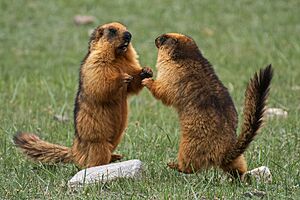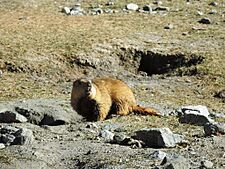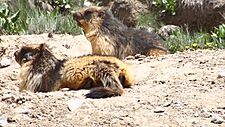Long-tailed marmot facts for kids
Quick facts for kids Long-tailed marmot |
|
|---|---|
 |
|
| Long-tailed marmots in Suru Valley, Ladakh, India | |
| Conservation status | |
| Scientific classification | |
| Genus: |
Marmota
|
| Species: |
caudata
|
The long-tailed marmot (Marmota caudata), also called the golden marmot, is a type of marmot. Marmots are large rodents that belong to the squirrel family, Sciuridae. You can find these marmots in the mountains of central Asia. They like to live in open areas or places with a few trees, often near rocks where small juniper plants grow. The long-tailed marmot gets its name because it has a longer tail compared to other marmots. Scientists consider it a species of Least Concern, meaning it's not currently at high risk of disappearing.
Contents
What is a Long-Tailed Marmot?
*Above: M. c. aurea in Ladakh, India
*Below: M. c. caudata in Deosai National Park, Pakistan
The long-tailed marmot is a big, strong rodent. It can weigh up to 9 kilograms (about 20 pounds). Its weight changes a lot during the year. In spring, after sleeping all winter, it might weigh only 1.5 kg (3.3 lb). By autumn, before winter sleep, it can weigh up to 7.3 kg (16 lb). More than a quarter of its body weight can be fat at this time.
Male marmots are usually a bit bigger than females. Their body, from head to tail base, is about 37 to 80 centimeters (15 to 31 inches) long. Their tail is quite long, measuring about 16 to 28 cm (6 to 11 in). This means its tail can be more than half the length of its body. This is much longer than most other marmots.
The long-tailed marmot has a somewhat flat head with small ears. Its eyes are set high on its head. Its front legs are longer than its back legs.
Different Types of Long-Tailed Marmots
Scientists have found a few different types, or subspecies, of the long-tailed marmot. Three main ones are generally accepted: M. c. caudata, M. c. aurea, and M. c. dichrous. These types look a bit different in color and size.
The M. c. aurea subspecies is found in most places where long-tailed marmots live. It is usually a bright golden-yellow or orange-brown color. Its face is brownish, and the top of its head is often dark brown or black. The tip of its tail is often blackish.
The M. c. caudata subspecies has a brown face. Its sides and belly are yellowish. The back of its head and middle of its back are black. Its tail can be black or a mix of yellowish and black.
The M. c. dichrous subspecies has a black-brown belly. Its upper body can be either dark (blackish-brown) or light (light brown to cream).
Where Do Long-Tailed Marmots Live?
Long-tailed marmots live in several countries in central Asia. These include Afghanistan, Kyrgyzstan, Tajikistan, Uzbekistan, northern Pakistan, northwestern India, and western China. They live in mountain ranges like the Pamir Mountains, Hindukush, Karakoram, and the northwestern Himalayas.
These marmots can live at many different heights in the mountains. They are found from about 600 meters (2,000 feet) up to 5,200 meters (17,000 feet) above sea level. The highest they can go depends on where the permanent snow line is.
They prefer open areas or places with a few trees. This includes mountain meadows, grasslands, and even semi-deserts. They especially like rocky areas where small juniper trees grow. They tend to avoid places with salty soil.
How Long-Tailed Marmots Live
Long-tailed marmots often form small family groups. They usually have one male and one female who stay together, but up to seven adults might share the same area. These adults are usually related. Young marmots often stay with their family until they are about three years old. Even if other adult marmots join the group, usually only one adult female will have and raise babies each year.
Homes and Hibernation
A marmot family's home area is usually about 3 hectares (7.4 acres). In this area, they have about three burrow systems, which are like underground tunnels and rooms. They use one of these burrows to hibernate (sleep through the winter). They usually hibernate from September until April or May. During this time, the ground is covered in snow. They might use a different burrow for hibernation each year.
Life Cycle and Reproduction
Mating happens in late April and early May, sometimes even before the marmots come out of their burrows after winter. The mother marmot is pregnant for about four and a half weeks. A litter usually has about four pups (baby marmots). The pups come out of the nest when they are about six weeks old.
Sadly, only about half of the pups survive their first summer. Some are caught by predators, and others might be killed by adult males joining the group. Most adult marmots survive the winter hibernation. However, more young marmots die during their first winter than adults. Females usually don't have babies until they are four years old.
Daily Life
Long-tailed marmots are active during the day. They spend their time eating plants. They are most active in the morning, spending about 40% of that time looking for food. When they come out of their burrow, they spread out to find food, not staying in a tight group. They either pick food from the ground with their mouths or pluck it from taller plants.
Sometimes, a marmot will stand on its back legs to look around for danger. Marmots in a group talk to each other using special alarm calls when they see predators. They also listen to alarm calls from other marmot groups nearby.
Who Hunts Marmots?
Animals that hunt long-tailed marmots include the red fox (Vulpes vulpes), the grey wolf (Canis lupus), and the golden eagle (Aquila chrysaetos). The bearded vulture (Gypaetus barbatus) might also hunt them. On the Tibetan plateau, marmots are also a food source for the snow leopard.
See also




